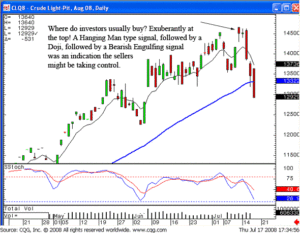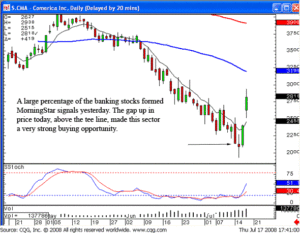A Doji represents the equilibrium between supply and demand in the markets. This signal is distinct in that prices open and close at or near the same level, indicating indecision of investors. If prices finish very close to the same level, then either a very small real body, or no real body is visible, and you therefore have a Doji candlestick. When learning to read candlestick chart patterns, the Doji if often the first discussed and deemed the most important. While it is not wise to use this candle alone, when online trading, the Doji marks the beginning of a minor or intermediate trend reversal, and is therefore very important to recognize.
The appearance of a Doji after a long uptrend is a warning to investors that the trend is either close to peaking, or has already peaked in the open markets. On the other hand, after a long downtrend the exact opposite is true and prices have been forced down. There are four types of Doji candlesticks that investors must learn before day trading stock online using Japanese candlesticks. These four types include the common Doji, the long-legged, the dragonfly, and the gravestone. The basic Doji signal was already discussed however the three additional types of Doji signals are explained below.
- Long-legged Doji – this Japanese candlestick signal has a long upper and lower shadow that is almost equal in length, however the trader should observe the candle’s close in relation to the midpoint. A close below the midpoint of the candle indicates weakness. This signal indicates that prices traded well above and below the session’s opening level, but the end result shows little change from the open.
- Dragonfly Doji – this signal forms when the open, high, and close are equal, and the low creates a long lower shadow. This signal indicates that sellers drove the prices lower during the session, however by the end of the session the buyers pushed the prices back to the opening level and the session high. This signal looks like a “T” with a long lower shadow and no upper shadow.
- Gravestone Doji – This Doji candlestick looks like the opposite of the dragonfly thus forming an upside down “T.” It has a long upper shadow and no lower shadow, and it forms when the open, low and close are equal. The high is what creates the long upper shadow. This candlestick trading signal indicates that the buyers drove prices higher during the session, and by the end of the session, the prices came back up to the opening level and the session low as a result of the sellers.
Japanese candlestick stock trading is an easier and more precise way to make profits in the stock market, in comparison to your basic line and bar charts. Continue to learn about other Japanese candlestick signals, in addition to the Doji candlestick, in order to be truly successful in the stock market.
Market Direction
What creates a reversal in a market? Investor perceptions! On any given day a reversal can occur, not based upon a change the fundamentals, but a change of investor sentiment. Crude oil pulled back from the $145 level to the $130 level. Will that have any significant change of company fundamentals? Probably not but the fact that the perception is that with crude oil prices heading lower, things could get better for equities. The fundamentals did not change in the past few days, investor perception changed.

CL
So what becomes the primary scan criterion if there appears to be a reversal in the markets? Literally hundreds of stocks showed reversal signals in the past two days. How does an investor scan for the best possible potential price moves? Candlestick analysis makes that a fairly easy process. Our Candlestick Forum training CDs constantly illustrate which reversal setups have the highest potential price moves. Knowing which direction the market is moving is the first facet for finding the high profit movers. Candlestick investor’s have the benefit of knowing whether a price move has credibility or not. Witnessing candlestick signals at the reversal area lends more credence to the new trend. The Dow formed a bullish engulfing signal after a spinning top. A close above the T-line revealed the Bulls did not have any apprehension at that level.

DOW
The steps for finding the highest potential trades in the new market direction are relatively simple. A scan for the strongest reversal signals in the list of sectors can be done just as easily as an individual stocks scan. Next, identifying the strongest reversal signals such as a candlestick signal followed by a gap up or a Kicker signal or the development of a price pattern move would create the best probabilities of be an in a strong stock move.
Once the sector or sectors that are showing the strongest reversal signals are identified, identifying the individual stocks in those sectors that have created the strongest reversal signals become the list to work off of. This is merely simple logic. Where are the identifiable strong signals? They will usually be in the strongest sectors.

CMA
Many investors have a problem taking profits. Candlestick analysis greatly relieves the fears related to coming out of a position. Good profits were made in the oil sector and the mining sector over the past four weeks. Why were the oil stocks acting strong? Because crude oil prices were steadily rising. Why was the market in general going down? Because crude oil prices were steadily rising. When was it time to take profits in oil stocks? When crude oil prices started breaking. This provided a double reason for taking profits. First of all, when crude oil prices start dropping, the first a knee-jerk reaction would be to sell oil stocks. That works for the short term most of the time. However, there is the additional factor. For those investors that have made good profits in oil stocks when the market was going down, they now have a pool of funds to pull from for the purchase of other sectors that may now benefit from a new market rally. Will oil stocks go higher? More than likely, but for the short-term, the candlestick signals reveal the probabilities are extremely high that it is time to be out of that sector.

HK
Candlestick signals indicate what is actually occurring in prices. We may think we can analyze what is going on in a specific market fairly well but that is not important. What we think as an individual has nothing to do with what is going to occur in the market or a stock price. Let the market tell you what the market is doing. If you learn how to use candlestick signals effectively, you will completely alter your analytical processes.
Good investing,
The Candlestick Forum Team
2-Day Seminar Package with $1000 in bonus products. View now
Speak Your Mind